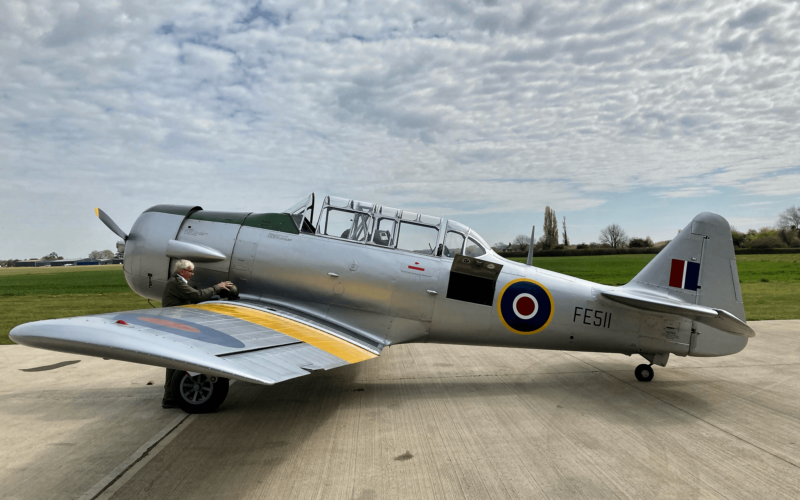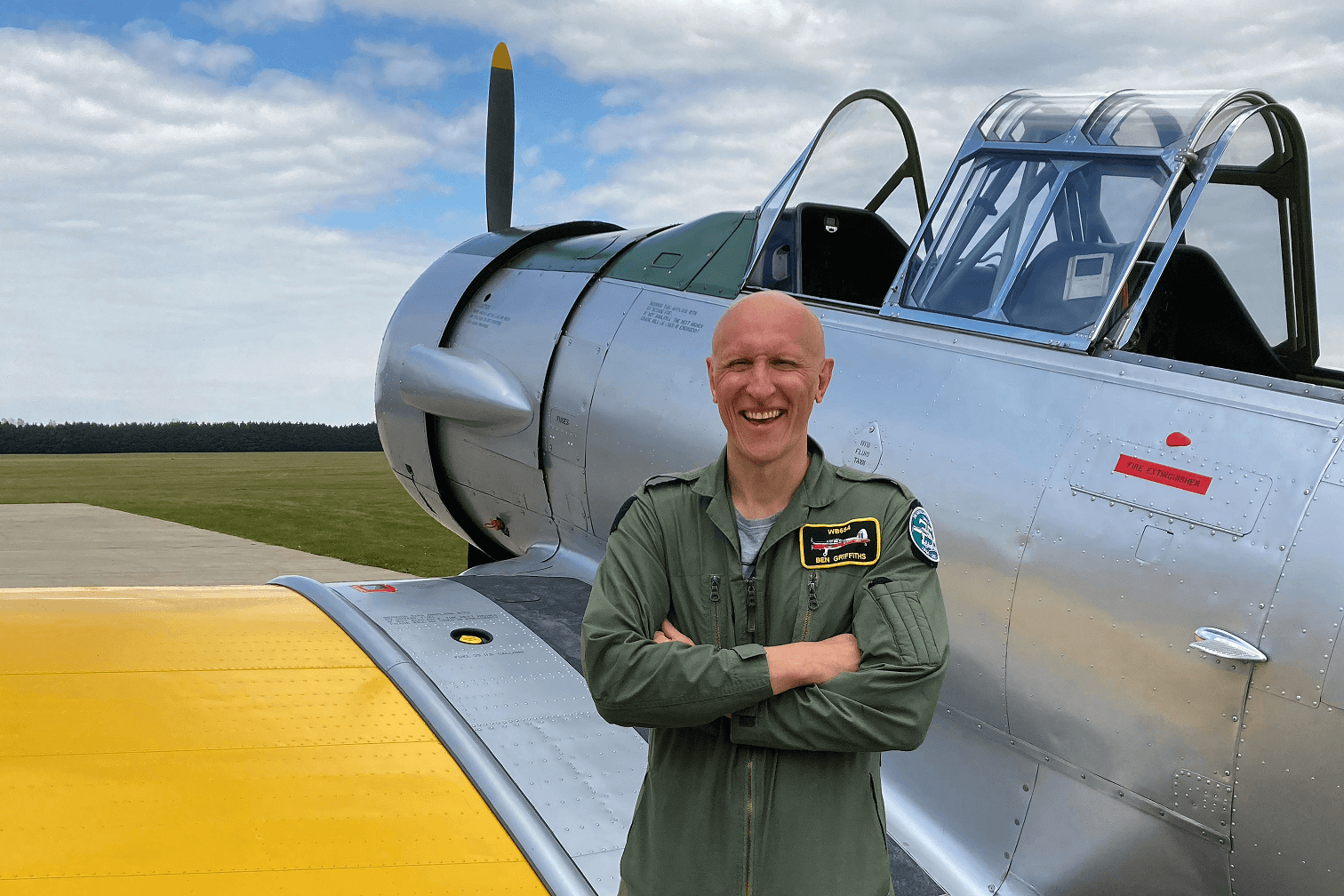As a relatively low-hours private pilot, I’ve spent the bulk of my time aloft flying vintage taildraggers. One type I got a taste of some 10 years ago and yearned to fly again was the Second World War-era T-6 Harvard. Big and heavy, it remains the gateway to more powerful ‘warbirds’ like the Spitfire, Hurricane and Mustang, and was once dubbed the pilot-maker for its role in preparing young fighter pilots for combat.
White Waltham, situated to the west of London, England, is a giant grass airfield with various runway directions and plenty of nearby unrestricted airspace, making it ideal for training. It also has true heritage, having been home to both de Havilland and Fairy aircraft companies in the past. Where better to become reacquainted with the Harvard?
My second encounter with the aircraft came last summer. Harvard FE511 is a beautiful example owned by James Brown, who also owns a Battle of Britain veteran Hawker Hurricane R4118. She was built in December 1942 in Quebec and served with the Royal Canadian Air Force in Ontario for the duration of the war, mainly to train pilots for the Royal Air Force, and finally arrived in the UK in 2016.
The Harvard was larger and more intimidating than I remembered. Just walking up to it gives an impression of scale compared with the Chipmunk, my usual mount. This is a massive old beast! At the front is a thirsty nine-cylinder Pratt & Whitney R-1340-AN1 Wasp radial engine. The Harvard is also quite complex in terms of systems with a retractable undercarriage and variable pitch propeller, plenty to manage compared with most light GA aircraft
Even climbing aboard is an adventure! The aircraft is 3.5m high, making it quite an ascent up to the cockpit. Once inside, it is surprisingly comfy. That large radial engine means the fuselage is also wide, so the cockpit is fairly spacious once you’re settled into the bucket seat and are sitting on your parachute pack. A lanyard is fixed to the seat, so if you are forced to bail out, your chute will automatically pull out behind you as you exit the aircraft.
A bit like sitting in an SUV, you feel high up off the ground with a decent view and plenty of interesting dials scattered all over the place, including some unfamiliar ones like Cylinder Head Temperature and a big old clock, which I wound up to time the flight. There is manifold pressure, a constant speed propeller and RPM to manage. There’s also no floor to speak of and you can see the control rods and cables below your flying boots.
Looking straight ahead, however, the view is not so good with the aircraft’s nose blocking sight of the ahead on the ground. This means it’s essential to weave side-to-side when taxiing to ensure you’re not going to bump into anything.
My instructor for the day was fellow Chipmunk pilot Peter Tuplin, who has more than 600 hours in Harvards as well having flown other warbirds. Sitting in the front cockpit for this first flight, Peter managed the navigation and radios, freeing me to make the most of just flying the thing and getting a feel for the machine from the rear seat.
Although heavy at around two tons, once you have your hands on the throttle and stick only tiny movements are required. Flying the Harvard is about fingers and thumbs and, most importantly, toes. It’s akin to thinking about where you want to go, applying a little back pressure on the stick when turning to keep the nose up and hold altitude. The same goes for the rudder pedals; it feels more like toe pressure than huge extensions of your leg. Too much and you’ll have the airplane skidding around the sky.
On departure from White Waltham, Peter performed a flawless takeoff. You get a sense of that power as the radial roars, and the aircraft accelerated faster than I was expecting. Climbing out of RW21 with a left-hand circuit, Peter handed control to me as we passed 1,000ft to keep the climb going and set the appropriate power as we turned towards the west and away from London Heathrow’s TMA.
We ascended to 2,000ft initially, then rose to 2,500ft outside controlled airspace to prepare for some general handling. Starting with some gentle turns to get a feel for the aircraft, I was working hard not to lose or gain too much height and grow accustomed to the pressures needed to guide this mighty machine in various directions through 90 degrees, 180 degrees and, finally, full 360 degree turns each way.
Next, climbing up to 3,500 feet, we tried some steeper turns with 45 degrees of bank, keeping them coordinated with sufficient back pressure on the stick to maintain altitude. The Harvard is quite heavy in pitch and so very easy to over-control, leaving you suddenly climbing or descending when you don’t want to.
I asked Peter to demonstrate a wingover. You can climb fairly quickly at 1,200ft/min thanks to that powerful engine, just making sure the propeller doesn’t overspeed as you go over the top and head downhill again. A very nice feeling. You’re flying a business-like military airplane.
The noise of the airflow was also very pronounced, particularly as the aircraft is flying around at about 180-200mph, with a maximum speed of 226mph – nearly twice my Chipmunk’s cruising speed. Going downhill, speed builds quickly, as does the noise!
After a short while, though, I was feeling comfortable and confident, with a sense that even after just 20 minutes in the Harvard I would get the most out of an upcoming Spitfire sortie (a story for another day). You get that sense of power from the aircraft but the key learnings for me were the lack of visibility on the ground, using the rudder properly when flying to maintain coordinated flight, and always making sure you are trimmed properly – it really does make life easier.
It’s an exciting machine to fly and I can’t wait to get back in the cockpit for the next trip. As I was warned beforehand it is very addictive. It’s just brilliant fun, until it’s time to pay the bill at £500 for 30 minutes for experience flights.


